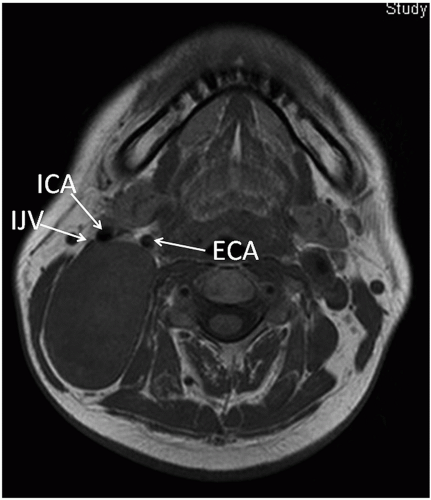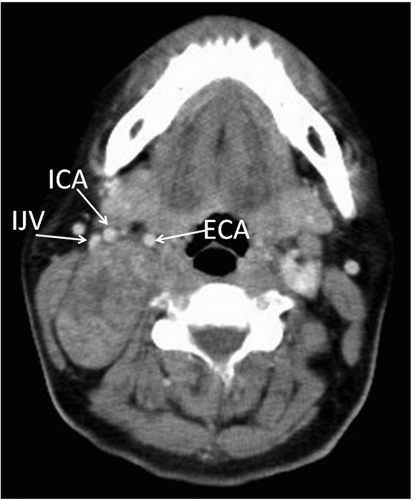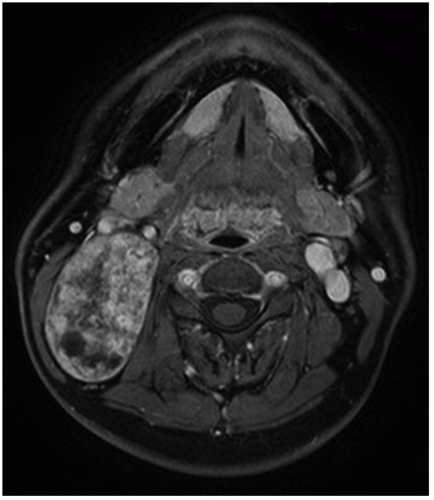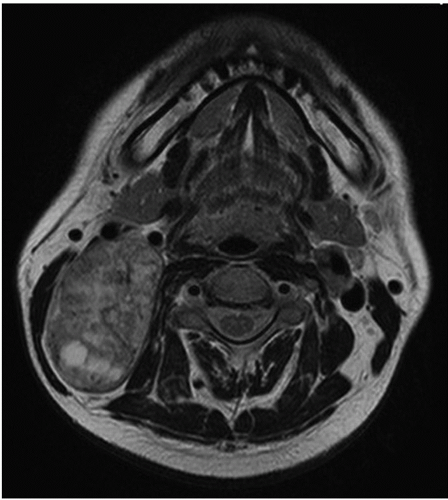Technique for Excision of Cervical Schwannoma
Seiji Kishimoto
INTRODUCTION
Schwannomas are benign tumors of the neural sheath with approximately 25% to 40% of extracranial schwannomas occurring in the head and neck region. Cervical schwannomas usually involve cranial nerves IX, X, XI, or XII, the cervical sympathetic chain, phrenic nerve, or cervical or brachial plexus (Table 10.1).
The diagnosis of cervical schwannoma begins with an accurate history and physical examination. The symptoms and signs are variable and depend primarily on the origin and location of the tumor. However, most patients are asymptomatic and only present with a mass in the neck. Schwannomas are frequently difficult to characterize by fine needle aspiration biopsy (FNAB). Clinical history, physical examination, and imaging studies, particularly magnetic resonance imaging (MRI), suggest the diagnosis. The best treatment is surgical resection. However, as schwannoma is a benign tumor without neurologic dysfunction, postoperative nerve paralysis can have a major impact on quality of life. Enucleation or tumor removal while preserving the involved nerve should thus be attempted if possible.
HISTORY
The initial complaint is usually a solitary asymptomatic cervical mass that slowly enlarges at a rate of 2.5 to 3 mm/year. However, when the mass extends from the parapharyngeal space to the neural foramena of the skull base (jugular foramen or hypoglossal canal), symptoms related to neurologic deficits, such as hoarseness, dysphagia, aspiration, dysarthria, or shoulder drop, can appear depending on the nerve involved. When the mass extends into a spinal foramen, paresthesia, weakness, and muscle atrophy of the upper limb and pain or paresthesia of the neck may be present.
PHYSICAL EXAMINATION
The mass is usually roughly spherical, with a smooth surface. In some cases, the tumor is fusiform in shape along the course of the involved nerve. Such a mass is usually mobile about an axis perpendicular to the long axis of the involved nerve, but with no mobility along the long axis of the involved nerve.
Sometimes, pulsation is palpable in the tumor. Discriminating pulsation from the carotid artery itself from a pulsatile tumor (carotid body tumor or paraganglioma) is important. If the carotid artery runs along the surface of the tumor, this indicates the possibility of schwannoma of the cervical sympathetic chain. However, if the carotid artery is displaced medially to the tumor, schwannoma of the vagus nerve (VN) may be suggested.
In the case of schwannoma of the cervical or brachial plexus, compression of the mass may cause pain or numbness of the neck, shoulder, or upper limb.
TABLE 10.1 Nerve of Origin for Cervical Schwannomas | |
|---|---|
|
INDICATIONS
The indications for surgical excision of schwannoma depend on the involved nerve, symptoms, size and location of the lesion, and risk of surgical intervention. Surgical excision should be considered to prevent progressive neurologic deficits due to an enlarging mass. Relatively small tumors usually involve only one nerve, but multiple nerves may come to be involved as the tumor enlarges. The disability resulting from dysfunction of multiple nerves is significant, and early surgical intervention should therefore be considered.
CONTRAINDICATIONS
The most important factor in determining indications for surgical excision is the age of the patient, since these tumors grow very slowly. In general, surgical intervention is not recommended for patients over 60 years old.
PREOPERATIVE PLANNING
Imaging Studies
Characteristic findings on computed tomography (CT) include a well-circumscribed, heterogeneously enhancing mass with or without central necrosis (Fig. 10.1). MRI reveals signal isointensity on T1-weighted imaging (Fig. 10.2), and a “target sign” is sometimes apparent after the administration of a contrast agent (Fig. 10.3).
 FIGURE 10.2 The mass appears signal isointense on T1-weighted axial MRI scan. IJV, internal jugular vein; ICA, internal carotid artery; ECA, external carotid artery. |
T2-weighted imaging reveals a mass with heterogeneous signal hyperintensity (Fig. 10.4). These findings suggest the diagnosis of schwannoma. Neither CT nor MRI demonstrates active irregular invasion to the surrounding tissue, as would be seen in malignant schwannoma.
Imaging diagnostic modalities such as ultrasonography, CT, and MRI offer great help in identifying the tumor and its positional relations to surrounding vessels and nerves. In cases with schwannoma of the VN, the tumor grows between the common/internal carotid artery and the internal jugular vein (IJV), increasing the distance between and separating the artery and vein (Fig. 10.5). In cases with schwannoma of the cervical sympathetic chain, no separation is observed between the IJV and common/internal carotid artery (Figs. 10.1, 10.2, 10.3 and 10.4).
Paraganglioma arising from the VN or carotid body should be differentiated from schwannoma using diagnostic imaging modalities. Paraganglioma is classically isodense when compared to muscle on precontrast CT, with more reliable homogeneous enhancement postcontrast. Post-gadolinium MRI sequences of paraganglioma show extremely bright contrast enhancement in a characteristic “salt-and-pepper” pattern, representing the low signal intensity of vascular flow voids.
Fine Needle Aspiration Biopsy
Stay updated, free articles. Join our Telegram channel

Full access? Get Clinical Tree





